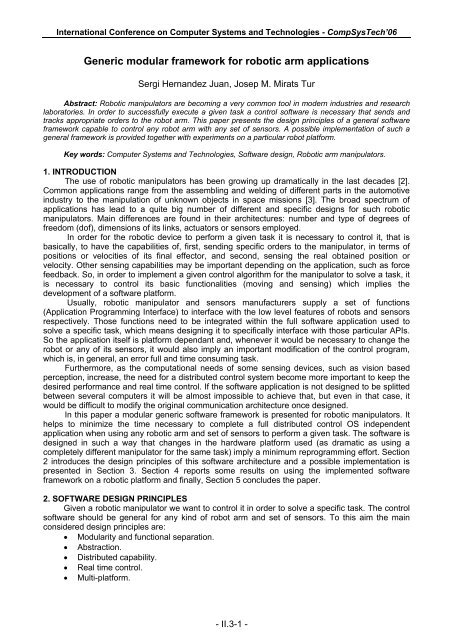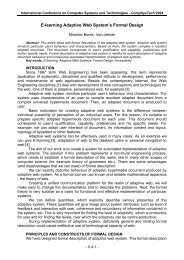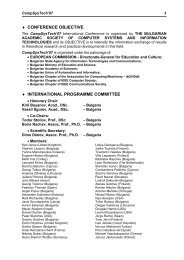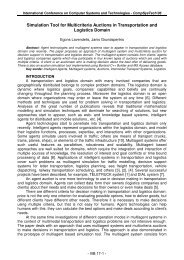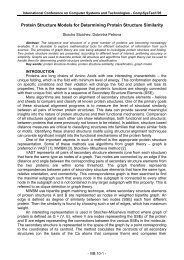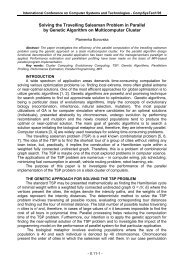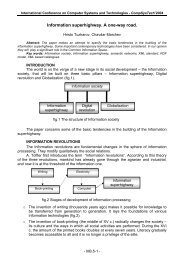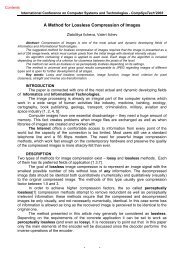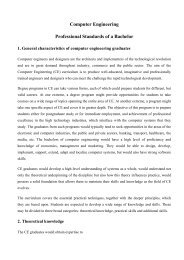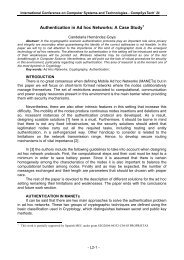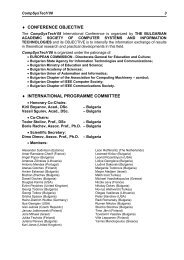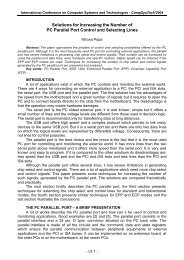Generic modular framework for robotic arm applications - Ecet
Generic modular framework for robotic arm applications - Ecet
Generic modular framework for robotic arm applications - Ecet
Create successful ePaper yourself
Turn your PDF publications into a flip-book with our unique Google optimized e-Paper software.
International Conference on Computer Systems and Technologies - CompSysTech’06<strong>Generic</strong> <strong>modular</strong> <strong>framework</strong> <strong>for</strong> <strong>robotic</strong> <strong>arm</strong> <strong>applications</strong>Sergi Hernandez Juan, Josep M. Mirats TurAbstract: Robotic manipulators are becoming a very common tool in modern industries and researchlaboratories. In order to successfully execute a given task a control software is necessary that sends andtracks appropriate orders to the robot <strong>arm</strong>. This paper presents the design principles of a general software<strong>framework</strong> capable to control any robot <strong>arm</strong> with any set of sensors. A possible implementation of such ageneral <strong>framework</strong> is provided together with experiments on a particular robot plat<strong>for</strong>m.Key words: Computer Systems and Technologies, Software design, Robotic <strong>arm</strong> manipulators.1. INTRODUCTIONThe use of <strong>robotic</strong> manipulators has been growing up dramatically in the last decades [2].Common <strong>applications</strong> range from the assembling and welding of different parts in the automotiveindustry to the manipulation of unknown objects in space missions [3]. The broad spectrum of<strong>applications</strong> has lead to a quite big number of different and specific designs <strong>for</strong> such <strong>robotic</strong>manipulators. Main differences are found in their architectures: number and type of degrees offreedom (dof), dimensions of its links, actuators or sensors employed.In order <strong>for</strong> the <strong>robotic</strong> device to per<strong>for</strong>m a given task it is necessary to control it, that isbasically, to have the capabilities of, first, sending specific orders to the manipulator, in terms ofpositions or velocities of its final effector, and second, sensing the real obtained position orvelocity. Other sensing capabilities may be important depending on the application, such as <strong>for</strong>cefeedback. So, in order to implement a given control algorithm <strong>for</strong> the manipulator to solve a task, itis necessary to control its basic functionalities (moving and sensing) which implies thedevelopment of a software plat<strong>for</strong>m.Usually, <strong>robotic</strong> manipulator and sensors manufacturers supply a set of functions(Application Programming Interface) to interface with the low level features of robots and sensorsrespectively. Those functions need to be integrated within the full software application used tosolve a specific task, which means designing it to specifically interface with those particular APIs.So the application itself is plat<strong>for</strong>m dependant and, whenever it would be necessary to change therobot or any of its sensors, it would also imply an important modification of the control program,which is, in general, an error full and time consuming task.Furthermore, as the computational needs of some sensing devices, such as vision basedperception, increase, the need <strong>for</strong> a distributed control system become more important to keep thedesired per<strong>for</strong>mance and real time control. If the software application is not designed to be splittedbetween several computers it will be almost impossible to achieve that, but even in that case, itwould be difficult to modify the original communication architecture once designed.In this paper a <strong>modular</strong> generic software <strong>framework</strong> is presented <strong>for</strong> <strong>robotic</strong> manipulators. Ithelps to minimize the time necessary to complete a full distributed control OS independentapplication when using any <strong>robotic</strong> <strong>arm</strong> and set of sensors to per<strong>for</strong>m a given task. The software isdesigned in such a way that changes in the hardware plat<strong>for</strong>m used (as dramatic as using acompletely different manipulator <strong>for</strong> the same task) imply a minimum reprogramming ef<strong>for</strong>t. Section2 introduces the design principles of this software architecture and a possible implementation ispresented in Section 3. Section 4 reports some results on using the implemented software<strong>framework</strong> on a <strong>robotic</strong> plat<strong>for</strong>m and finally, Section 5 concludes the paper.2. SOFTWARE DESIGN PRINCIPLESGiven a <strong>robotic</strong> manipulator we want to control it in order to solve a specific task. The controlsoftware should be general <strong>for</strong> any kind of robot <strong>arm</strong> and set of sensors. To this aim the mainconsidered design principles are:• Modularity and functional separation.• Abstraction.• Distributed capability.• Real time control.• Multi-plat<strong>for</strong>m.- II.3-1 -
International Conference on Computer Systems and Technologies - CompSysTech’062.1 Modularity and functional separationModularity and functional separation [5,1], together with code implementation dependentprinciples such as reusability and robustness [6], are the most basic software design principles thatcan be found in commercial as well as non-commercial software <strong>applications</strong>. The aim of<strong>modular</strong>ity is to encapsulate all the features of a physical or logical entity into some kind ofstructure to prevent other entities to directly modify them. Instead, a set of functions is provided <strong>for</strong>each of these entities to access their attributes. Such set of functions is usually referred to aninterface, term that will be used all throughout the paper.Such an interface should provide, first, the necessary functions to modify the entitiesattributes and to retrieve their values, and second, provide those functions required to carry outtheir specific functionality, such as acquiring data from a sensor or executing a given trajectory witha robot. Furthermore, <strong>modular</strong> design allows the software designer to limit the required changeswhenever a module needs to be modified or extended.The functional separation main issue is to isolate as much as possible the application itselffrom the user interface and the underlying hardware. The user interface is the set of functions thatallow the interaction between the user and the software application. For this case the functionalseparation is easily accomplished by providing a complete enough interface <strong>for</strong> the highesthierarchical module, so the user interface (graphical, command line, web based, etc.) just needs tocall a function or a sequence of functions from the interface to carry out any desired task.On the other hand, the separation from the low level hardware is much more complicate. Itwill always be necessary to develop a device driver <strong>for</strong> any external device that will depend on thelink type between the external device and the application (RS-232, Ethernet, PCI, etc.). In order toovercome this problem, each developed device driver should use a virtual communication device(VCD) which will be used <strong>for</strong> any input/output access to the external device. It works as aplaceholder <strong>for</strong> any real communication device and implements all the features needed to providean efficient channel of communication: input and output queues <strong>for</strong> data flux control, asynchronousnotification of received data, multithreaded execution and error handling capabilities; but it notincludes the specific implementation to actually open, configure, close or send and receive data toand from the external device, which must be defined <strong>for</strong> each particular implementation.By using such a VCD it is possible to easily change the way the application interfaces withthe external devices, that is, external devices may be connected either directly or remotely withoutmodifying the application. This idea is further developed in section 2.3 where the principle ofdistributed control is introduced and described.As outlined at the beginning of this section, these two basic and simple principles apply toany software application, but, in the specific case of <strong>robotic</strong> <strong>applications</strong>, new challenges arisewhich can be handled using other design principles as described next.2.2 AbstractionEach physical device (i.e. sensor, motor controller, robot, etc.) has a given functionality whichis independent from the particular implementation. So, the corresponding software module has toprovide a generic interface which allows any other module to access all its functionality withoutnoticing the implementation details.For the particular case of <strong>robotic</strong> <strong>arm</strong> <strong>applications</strong>, the set of generic modules correspond tothe robot, the <strong>for</strong>ce and position feedback devices, the motion controller and each of the motorcontrollers. The abstraction of the basic functionality takes place in all of these modules, from thelow level device driver interface to the high level robot control interface.For example, a motor control module should provide the same functions to configure themotor motion (absolute or relative motion, motion blending, etc.), to load the motion parameters(position or speed) and to start and stop the motion whatever the motor controller used. A robotmodule should provide the same functions to carry out any arbitrary trajectories, whatever thekinematic and dynamic models of the robot and the particular feedback devices are.There<strong>for</strong>e, this set of generic modules should provide, first, a generic interface to accesstheir specific functionality, second, a basic implementation, common to any plat<strong>for</strong>m, and, finally,the necessary communications between the different modules.All the high level control algorithms need in<strong>for</strong>mation about the robot's kinematic anddynamic models, the motors controllers and/or the feedback devices, but due to the genericinterface provided by each module, the control algorithm will be always the same.- II.3-2 -
International Conference on Computer Systems and Technologies - CompSysTech’06Thus, given a set of generic modules, and in order to adapt the software to a specificplat<strong>for</strong>m, the only functions that are required to be implemented are those describing the robot'sarchitecture and the ones that interface with the device drivers. Since all the basic controlalgorithms and inter-module communications are already implemented, the time needed to migratefrom one plat<strong>for</strong>m to another is highly reduced.2.3 Distributed capabilityAs the computational needs of some feedback devices increase, it becomes necessary tosplit the control application through several computers so as to keep per<strong>for</strong>mance and real-timecontrol. Also, due to the absolutely different requirements <strong>for</strong> each application, the way the controlsoftware is splitted should be flexible enough to adapt to different configurations with little or nomodification at all of the program.Given the generic modules introduced in the previous section, the easiest way to split theapplication is through these modules. Each of them may be local or remote to the users' computer.In the <strong>for</strong>mer case nothing has to be done since all the modules functionality is directly accessiblethrough function calls. On the other hand, when a module is executing remotely in anothercomputer several new features must be added to it. First of all, it is necessary to define acommunication protocol to both, send the commands and parameters, and receive the operationresults. It is required, also, to keep two different versions <strong>for</strong> each module: one working as aserver, waiting <strong>for</strong> commands and actually carrying out the necessary actions, and the otherworking as a client, sending the commands and waiting <strong>for</strong> them to end.Finally, it's also necessary to define a communication device to handle the data transferbetween the host and the client. To this end, the VCD explained in 2.1 can be used given the manydifferent available possibilities: Ethernet in research environments, CAN bus in industrialenvironments or even pipes between processes in the same computer.A part from the great flexibility in designing distributed control systems, by using thisapproach, it is also possible to easily interface the application to a simulator in order to validate thecontrol algorithms instead of trying them into the real plat<strong>for</strong>m.2.4. Real controlAnother design principle that must be taken into account is that most control <strong>applications</strong>must execute in real time [4]. This implies that none of the modules introduced so far can beblocked waiting <strong>for</strong> data or an event to take place. Since blocking is in general unavoidable due tothe asynchronous nature of the events to wait <strong>for</strong>, and continuously polling is not efficient in termsof CPU usage, the use of multiple threads of execution becomes necessary.Although extremely powerful, multi-threaded <strong>applications</strong> introduce a lot of new problemssuch as thread synchronization, shared memory control and the thread handling itself. The use ofsuch advanced programming techniques considerably increases the application complexity. Inorder to simplify the use of threads, it is necessary to define a new set of modules to handle thethreads, the mutual exclusion methods and the logical events.In order to include the functionalities to create and handle multiple threads, as well astransparently handling the shared memory and the logical event notifications used <strong>for</strong>synchronization, each of the generic modules introduced in section 2.2 will have either to inherit oruse the new defined thread modules. One of the main problems when using these features is thatthey are strongly dependent on the operating system used, issue that shall be addressed in thenext section.2.5. Multi-plat<strong>for</strong>mNowadays, both Windows and Linux operating systems (O.S.) are world wide used in mostscientific and industrial environments. A control application that can run in any of these O.S. shouldbe much more useful. There exist some programming languages specially designed to generatemulti-plat<strong>for</strong>m <strong>applications</strong> but which are not generally suited <strong>for</strong> real time <strong>applications</strong>, since theyare interpreted in run time and not compiled be<strong>for</strong>e execution (i.e. Java).Even though, considering the software <strong>framework</strong> presented so far, only few of the modulesactually depend on the O.S. used. These are the VCD and those used to handle threads, sharedmemory and logical events. If the end user interface is based on a windowed graphical scheme, itwill be also necessary to use a library which is independent from the underlying O.S.- II.3-3 -
International Conference on Computer Systems and Technologies - CompSysTech’06receive data from the low level hardware and CPipe to exchange data between the applicationmodules. Both CPipe and CCom, just implement the low level physical access to thecommunication devices. Another communication class is used to split the application throughseveral computers using a Local Area Network (CSocket) to test the distributed capability.By using the base <strong>framework</strong> introduced in section 3 to design a software application <strong>for</strong> thisparticular plat<strong>for</strong>m, it has been possible to develop a control software using external position and<strong>for</strong>ce feedback in a short time. The only modules that were necessary to be implemented were thekinematic and dynamic models of the robot, adapting the motor control and feedback modules tothe characteristics of the particular device drivers and the way those modules interface to thehardware through the serial hub (CHub).Finally, it has been possible to split the control application through several computers usingthe distributed capability principle, in which the software <strong>framework</strong> is based, with minimummodification of the source code. For every remote module it was only necessary to assign acommunication device (CSocket) and create a main program which generates the correspondingpart of the control application <strong>for</strong> each computer.5. CONCLUSIONS AND FUTURE WORKGiven a <strong>robotic</strong> <strong>arm</strong> we want to control it in order to solve a task. The control software shouldbe general <strong>for</strong> any kind of robot <strong>arm</strong> and set of sensors. This paper introduces a set of designprinciples which seek to reduce <strong>robotic</strong> <strong>applications</strong> design and implementation time so reducingthe errors present in any practical implementation as well. Then, a possible implementation of thegeneral software <strong>framework</strong> proposed in section 2 is developed. Experiments show that thesolution presented in this paper, although its limitations, allow the <strong>robotic</strong> <strong>applications</strong> designer tosave development time while keeping the overall complexity low. Although the control algorithmsalways worked, due to the bandwidth requirements of some modules (i.e. motor control), theper<strong>for</strong>mance achieved <strong>for</strong> some configurations is severely limited. There exists open-source<strong>applications</strong> which handle similar problems [7,8] but they are not well fitted <strong>for</strong> small control<strong>applications</strong> like the one presented in section 4 due to the high complexity involved.We have learnt that because of limitations in the programming language used to develop theapplication, some of the design principles presented in section 2 can not be completely fulfilled,and the final application itself is highly sensitive to implementation issues. Also, to completely verifythe design principles it would be necessary to evaluate the ef<strong>for</strong>t required to design a controlapplication <strong>for</strong> multiple and heterogeneous plat<strong>for</strong>ms.REFERENCES[1] F. Buschmann, Rational architectures <strong>for</strong> object-oriented software systems, Journal of Objectorientedprogramming, pp 30-41, 1993.[2] P.Dario, R. Dillman, H.I. Christensen, Euron Roadmap document, 2005[3] Hirzinger, G.; Sporer, N.; Schedl, M.; Butterfass, J.; Grebenstein, M, Robotics and mechatronicsin aerospace, 7th International Workshop on Advanced Motion Control, 2002.[4] Y. Kuo, A distributed real-time <strong>framework</strong> <strong>for</strong> <strong>robotic</strong>s <strong>applications</strong>, Master's Thesis, Univeristyof Auckland, Submitted 2004.[5] B. Meyer, Object-oriented software construction, Prentice-Hall, 1997.[6]I.A.D. Nesnas, Toward developing reusable software components <strong>for</strong> <strong>robotic</strong> <strong>applications</strong>,Technical report JPL, 2001.[7] ORCA, http://www.orca-<strong>robotic</strong>s.source<strong>for</strong>ge.net/, 2004.[8] OROCOS, Open Robot Control software Open Robot Control Services, http://www.orocos.org.ABOUT THE AUTHORSSergi Hernandez Juan, PhD student, Institut de Robòtica i In<strong>for</strong>màtica Industrial (IRI), Spain,Phone: +34 93 401 57 91, Е-mail: shernand@iri.upc.es.Josep M. Mirats Tur, post-doc researcher, Institut de Robòtica i In<strong>for</strong>màtica Industrial (IRI),Spain, Phone: +34 93 401 07 75, Е-mail: jmirats@iri.upc.es.- II.3-6 -


